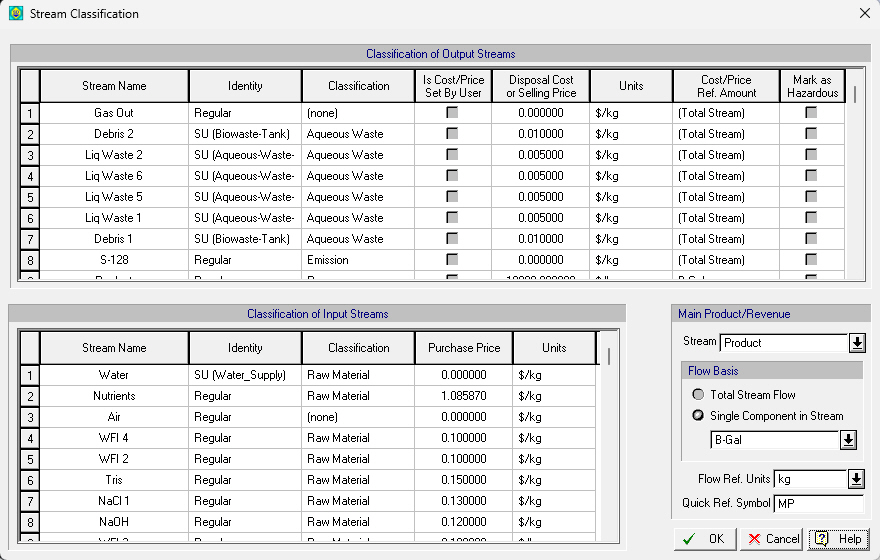

This dialog can be accessed by selecting Stream Classification on the Tasks menu of the application.
From this dialog you may specify the classification of the input and output streams. You may also specify:
● a selling price for an output stream classified as revenue or credit, or
● a treatment/disposal cost for an output stream classified as one of the wastes (solid waste, aqueous waste, organic waste or emission), or
● a processing fee for an input stream classified as revenue or cleaning agent.
For an input stream classified as raw material, a purchasing price is automatically calculated by the program based on the stream’s composition and the purchasing prices of its ingredients.
|
|
The tables for the input and output streams include a column that show the stream’s identity (see Stream Identity). Depending on the stream’s identity its classification may be automatically set and cannot be changed from this table. For example, if an output stream’s identity displays ‘SU’ and the name of a receiving storage unit, then the classification of hte stream is matched with the classification of the assigned storage unit (SU). If the assigned storage unit does NOT have a classification then, you can assign one here (or from the Identity tab of the stream, see Input Stream Dialog: Identity Tab or Output stream Dialog: Identity Tab). The identity itself of the stream cannot be changed from this table but only from the stream’s Identity tab. |
In general the price of a bulk stream (in $/kg) with a classification other than (none) is estimated by the program based on the purchasing price, selling price or waste treatment cost of the various ingredients (components and stock mixtures) that compose that stream. More specifically the cost or price reference amount for defining the stream price is by default determined by the total stream, however the user may select to define the price of a stream based on a single component in the stream. This can be done by changing the selection in the Cost/Price Ref. Amount column. The prices of components and ingredients are set through the economics tab of the component properties dialog. The price of a discrete raw material stream (in $/entity) is set through the stream’s simulation data dialog. The unit cost (prices) of raw material streams along with the results of the material balances determine the raw materials costs that appear in the Itemized Cost Report (ICR) and Economic Evaluation Report (EER).
An output stream may also be marked as hazardous by checking the last column of the ‘Classification of Output Streams’ table. Streams that are marked as hazardous are included in the Hazardous Streams Section of the Environmental Impact Report (EIR).
Finally, a ‘Main Product/Revenue’ stream and flow basis can be specified from the respective drop-down list that is present in this dialog. The list will contain input and output streams that are classified as revenue. The selected stream and flow basis are only considered in economic reports (Executive Summary Dialog and Economic Evaluation Report (EER)).
If the main product/revenue stream is a bulk stream, its flowrate (for reporting production or processing unit cost) can be based either on the total stream flow or the flow of a particular component in that stream. For discrete streams, the first option only (total discrete flow) is available. You may also select the flow reference units for bulk streams to be based on mass, volume or mol. For discrete streams, the only option for the flow reference units is ‘entity’. Finally, you may specify a quick reference symbol (used as a shortcut name) for the main product/revenue stream.
For more information on the classification of input and output streams, see Classification of Input and Output Streams.